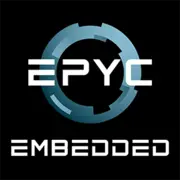AMD EPYC Embedded 8224P

The AMD EPYC Embedded 8224P processor is a powerhouse CPU designed specifically for server applications. With a total of 24 cores and 48 threads, this processor is capable of handling heavy workloads and demanding tasks with ease. The 5 nm technology ensures efficient performance and reduced power consumption, making it an excellent choice for data centers and cloud computing environments.
The base frequency of 2.55 GHz and max turbo frequency of 3 GHz ensure fast and responsive performance, even when dealing with complex computations and multitasking. The large 64 MB L3 cache further enhances the processor's ability to handle massive amounts of data efficiently.
With a TDP of 160W, this processor may require robust cooling solutions, but the high power consumption is justified by the exceptional performance it delivers. Overall, the AMD EPYC Embedded 8224P is a top-tier processor that offers exceptional processing power, multi-threaded performance, and energy efficiency, making it an ideal choice for high-performance server applications. Whether you’re running virtual machines, managing databases, or processing big data, this processor is more than capable of handling the task with ease.
Basic
Label Name
AMD
Platform
Server
Launch Date
September 2023
Model Name
?
The Intel processor number is just one of several factors - along with processor brand, system configurations, and system-level benchmarks - to be considered when choosing the right processor for your computing needs.
EPYC Embedded 8224P
Code Name
Siena
Foundry
TSMC
Generation
EPYC(Zen 4c (Siena))
CPU Specifications
Total Cores
?
Cores is a hardware term that describes the number of independent central processing units in a single computing component (die or chip).
24
Total Threads
?
Where applicable, Intel® Hyper-Threading Technology is only available on Performance-cores.
48
Performance-core Base Frequency
2.55 GHz
Performance-core Max Turbo Frequency
?
Maximum P-core turbo frequency derived from Intel® Turbo Boost Technology.
3 GHz
L1 Cache
64 KB per core
L2 Cache
1 MB per core
L3 Cache
64 MB shared
CPU Socket
?
The socket is the component that provides the mechanical and electrical connections between the processor and motherboard.
AMD Socket SP6
Bus Frequency
100 MHz
Multiplier
25.5
Unlocked Multiplier
No
Technology
?
Lithography refers to the semiconductor technology used to manufacture an integrated circuit, and is reported in nanometer (nm), indicative of the size of features built on the semiconductor.
5 nm
TDP
160 W
PCIe Version
?
PCI Express is a high-speed serial computer expansion bus standard used for connecting high-speed components, replacing older standards such as AGP, PCI, and PCI-X. It has gone through multiple revisions and improvements since its initial release. PCIe 1.0 was first introduced in 2002, and in order to meet the growing demand for higher bandwidth, subsequent versions have been released over time.
5
Transistor Count
17.75 billions
Memory Specifications
Memory Type
?
Intel® processors come in four different types: Single Channel, Dual Channel, Triple Channel, and Flex Mode. Maximum supported memory speed may be lower when populating multiple DIMMs per channel on products that support multiple memory channels.
DDR5-4800
Memory Channels
?
The number of memory channels refers to the bandwidth operation for real world application.
6
ECC Memory Support
Yes
GPU Specifications
Integrated Graphics Model
?
An integrated GPU refers to the graphics core that is integrated into the CPU processor. Leveraging the processor's powerful computational capabilities and intelligent power efficiency management, it delivers outstanding graphics performance and a smooth application experience at a lower power consumption.
N/A
Miscellaneous
PCIe Lanes
96
Share in social media
Or Link To Us
<a href="https://cputronic.com/en/cpu/amd-epyc-embedded-8224p" target="_blank">AMD EPYC Embedded 8224P</a>